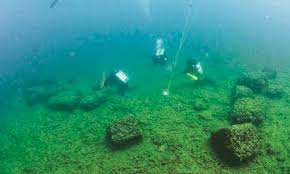Stonehenge in Lake Michigan: Let’s discover this mystery that Lake Michigan holds and how these rocks have delighted scientists and anthropologists around the world.
Archeologists uncovered something considerably more exciting than they had planned for when searching for shipwrecks in Lake Michigan.
While looking for shipwrecks in Lake Michigan, archeologists discovered something considerably more exciting than they had anticipated. A rock with an old mastodon sculpture, as well as a sequence of stones structured in a Stonehenge-like pattern.
The iconic Stonehenge in the United Kingdom is one of the world’s most recognized ancient monuments. Yet it is not the only stone structure of its sort. Similar stone alignments have been discovered in England, Ireland, Scotland, and Wales. It appears, in Lake Michigan.
Archaeologists had been engaged to scan the Lake’s floor near Traverse City, Michigan, and use sonar technology to study historic boat wrecks. They came upon sunken boats, automobiles, and even a Civil War-era pier. Among the expected discoveries was a potentially ancient surprise.
Stonehenge in Lake Michigan
Structures comparable to Stonehenge are ubiquitous, particularly in the United Kingdom. So, it was surprising to discover something similar even closer to home and underwater.
The stones are arranged in a circle 40 meters beneath the surface of Lake Michigan. Their date is at least 10,000 years old. One stone in the outer circle features a mastodon sculpture, an ancient species that resembles an elephant and became extinct around 10,000 years ago.
Of course, the obvious issue is how the stones ended up under one of the world’s greatest lakes.
The issue is that many professionals want to examine the construction for themselves to assess its validity, but most experts do not dive, so they have a dilemma. Many people wonder if the rocks were put on purpose or if they happened by chance. Other stone circles have been discovered in the vicinity, so it would not be an unexpected find. There has been some new information on the condition of the stones.
Under Water Stonehenge Found

Lake Michigan rocks resemble a small Stonehenge. Scientists uncovered a stone building at a depth of 12 meters in Lake Michigan in 2007 while hunting for the wreckage of lost ships (USA). Marc Holly, a professor of underwater archeology at the Northwestern University of Michigan, and his colleague Brian Abbott found the find.
They think that this structure, comparable to Stonehenge, is roughly 9000 years old, although there is a sculpture in the shape of a mastodon on one of the stones, which died away more than 10,000 years ago. The precise coordinates of the discovery are yet unknown.
Michigan is a freshwater lake in the United States and one of the Great Lakes of North America. The only one of the Great Lakes is entirely within the United States, and the biggest of the Great Lakes is within the United States. At the south of Lake Superior, it is linked to the Lake Huron Strait of Mackinac and the Mississippi River system – the Chicago Canal – Lockport.
Hydrographically, Michigan, and Huron constitute a single system, yet geographically, they are different lakes.
What’s the Story Behind the Stonehenge in Lake Michigan ?
It might be a miniature replica of an ancient hunting structure like the one discovered in Lake Huron. VanSumeren said a hunting blind underwater “doesn’t have the same ring to it” as a widely famous prehistoric monument like Stonehenge, which is why it was mislabeled in headlines.
The shallow rocks in Grand Traverse Bay were 35 feet underwater, unlike the Caribbean-clear deep water where the Drop 45 Drive Lane was located in Lake Huron. They have algae, silt, and invasive mussels. This makes it impossible to tell whether they’re natural or artificial.
Stonehenge Beneath the Waters of Lake Michigan
It is a sequence of stones 40 feet beneath the surface waters of Lake Michigan. They are in a circle and one of which appears to include carvings of a mastodon. The engravings might be as old as 10,000 years, coinciding with the existence of people and mastodons in the upper Midwest after the Ice Age.
The circular pictures produced by this object are surreal; they form cryptic dioramas of long-lost debris on the lakebed, like some bizarre new art-historical branch of landscape depiction. Shipwrecks (such as the Tramp, which sank in 1974); a “junk pile” of ancient boats and automobiles; a Civil War-era pier; and even an old buggy are among the geographical features that divers can explore.
These are anthropological relics that will soon become part of the geology of the Lake; they are our future trace fossils.
Whatever the solution is, the idea of underwater archaeology, prehistoric relics, and forgotten ships colliding to generate a midwestern mystery is intriguing enough to consider.
The Enigma in the Lake: Stonehenge in Lake Michigan
Unlike the previously mentioned Rock Lake Pyramids, the site itself is not a hoax. However, this history that has grown up around it is, and the “Stonehenge” is one of the rare archaeological sites where this is the case.
Michigan later divided its rivers into twelve underwater preserves as easier-to-manage “chunks”. These stones stood out because they ran in a fairly circular pattern, although the bottom of Grand Traverse Bay is normally sand. It was unusual and out of place. They merely dove and photographed the stones before moving on because their main objective was the shipwrecks within the park.
The truth inside this Lake
After analyzing images of the stone arrangement, Dr. Holley discovered what seemed to be a petroglyph of an ancient mammoth/mastodon. Because no one affiliated with the project had prior expertise with a site like this or with prehistoric rock art, they did another dive to confirm the find and their collected photographs.
With this petroglyph, they were sure that this was, in fact, a cultural site of considerable antiquity, given that woolly mammoths and mastodons had become extinct in the midwestern United States some 11,000 years ago.
They discovered something that appeared to be culturally and completely distinct that they had never encountered before. Thus there was some dispute about how to proceed and act appropriately.
The Truth About the Stonehenge Replica in Lake Michigan
ZME Science claimed in 2017 that they utilized sonar technology. They identify sunken boats, automobiles, a Civil War-era pier, and buildings that resembled boulders arranged in a circle similar to those found at Stonehenge in England where roughly 100 stones stood in a circle. Another unearthed rock revealed etchings that suggested it was a petroglyph. The picture-on-a-rock did not form part of the circle.
So, we hope you enjoyed our Lake Michigan review!
Recommended Reads
- All Inclusive Resorts in the Maldives-Top 20
- Best Haunted Houses in Ohio
- Maldives or Bora Bora: Which is a Better Vacation Spot?
- Major Cities in Africa-Top 10
- Best Places to Visit-Top 60 for 2022
OYO Hotels USA
- Save 33% on your Scrubbed Clean Stays at OYO Hotels in Atlanta
- Get 33% + 10% Extra Off on Scrubbed Clean stays longer than 7 nights


